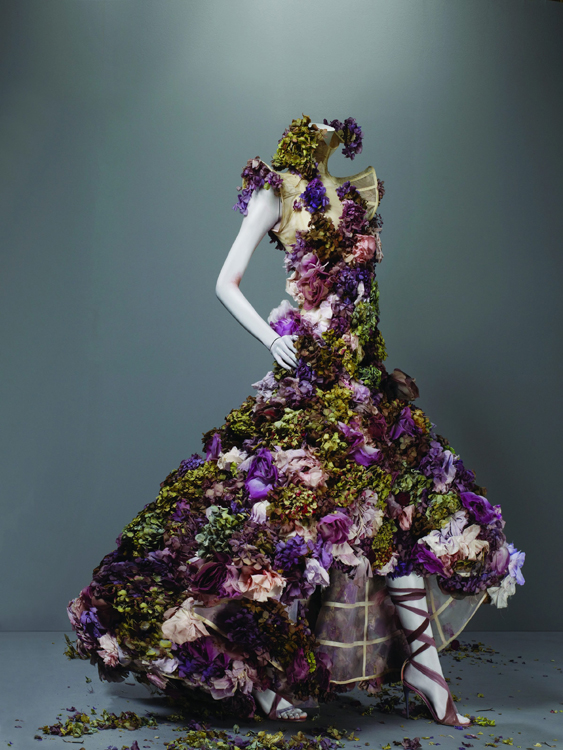I had been waiting for months to see this exhibition at the Metropolitan Museum New York and finally had the chance to wander through McQueen’s archive. I arrived well before opening time and did well by doing so since I’m not keen on queuing for hours. It would have been worth it, though, no doubt.
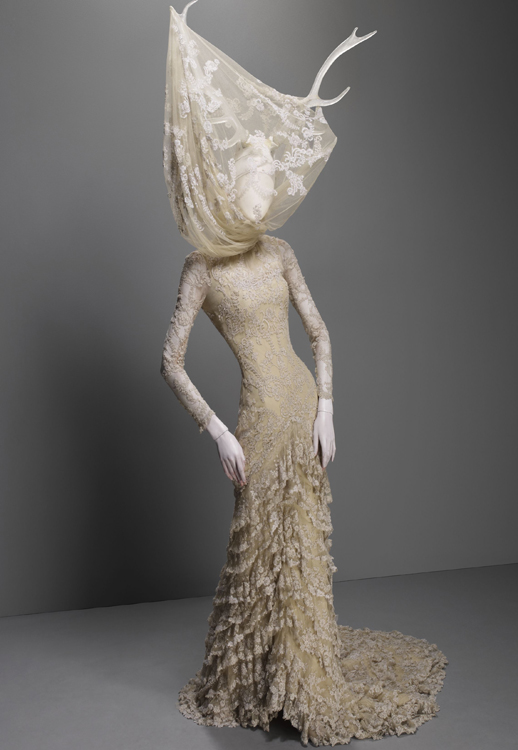
As we can read in the exhibit labels: ‚Alexander McQueen was best known for his astonishing and extravagant runway presentations, which were given dramatic scenarios and narrative structures that suggested avant-garde installation and performance art,‚ said Andrew Bolton, Curator of the exhibition and the The Costume Institute. ‚His fashions were an outlet for his emotions, an expression of the deepest, often darkest, aspects of his imagination. He was a true romantic in the Byronic sense of the word – he channeled the sublime.‚
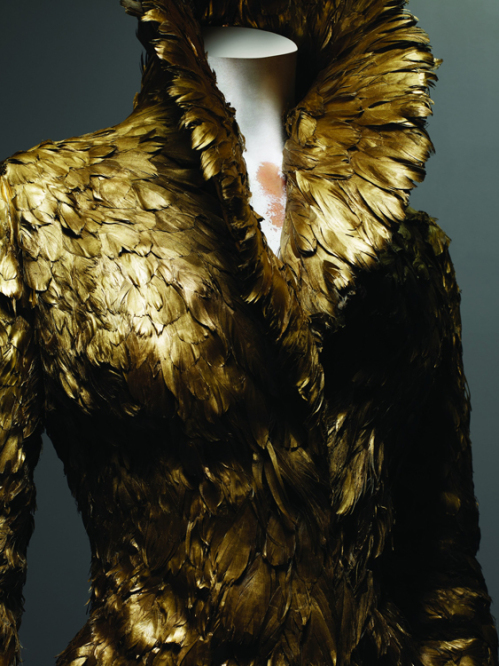
Alexander McQueen was a designer whose dazzling creativity and startling originality were expressed through the technical virtuosity of his fashions and the conceptual complexity of his runway presentations, suggestive of avant-garde installation and performance art. His vision of fashion relentlessly questioned and challenged the requisites of clothing. Rare among designers, he saw beyond clothing’s physical constraints to its ideational and ideological possibilities. For McQueen, fashion and politics were linked inexorably, as were fashion and emotions. Through his runway presentations, McQueen validated powerful emotions as compelling and undeniable sources of aesthetic experience. Like a painter or writer of the Romantic Movement, McQueen associated unfettered emotionalism with the appreciation of beauty. Over and over again, his shows elicited an uneasy pleasure that merged wonder and terror, incredulity and revulsion, feelings associated with the Romantic concept of the Sublime. Beyond the Sublime, however, McQueen engaged deeply with other philosophical abstractions of the Romantic Movement – individualism, historicism, nationalism, exoticism, primitivism, and naturalism – which are presented as the dominant thematics of this exhibition. What comes to light is a vision of fashion that aimed to reconstitute the Romantic past into the Postmodern present. McQueen once remarked that he was ‚overly romantic.‘ But it was precisely his romantic yearnings that propelled his creativity and advanced fashion in directions both unimagined and unprecedented.
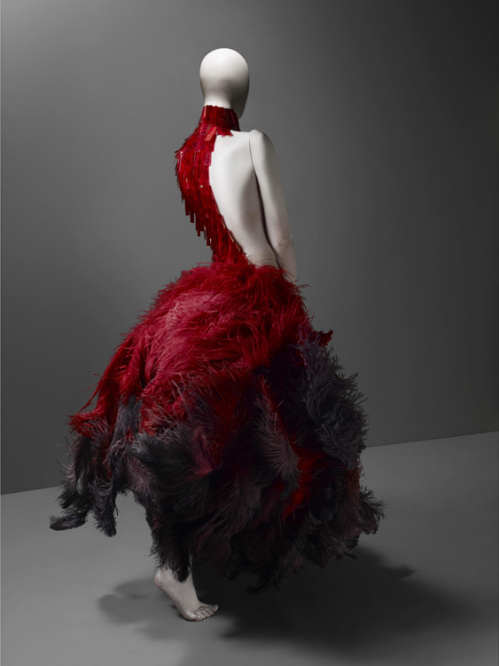
The exhibition in the Metropolitan Museum New York features approximately 100 ensembles and 70 accessories from Mr. McQueen’s prolific 19-year career. Drawn primarily from the Alexander McQueen Archive in London, with some pieces from the Givenchy Archive in Paris as well as private collections, signature designs including the bumster trouser, the kimono jacket, and the three-point ‚origami‚ frock coat are on view. McQueen’s fashions often referenced the exaggerated silhouettes of the 1860s, 1880s, 1890s, and 1950s, but his technical ingenuity always imbued his designs with an innovative sensibility that kept him at the vanguard.
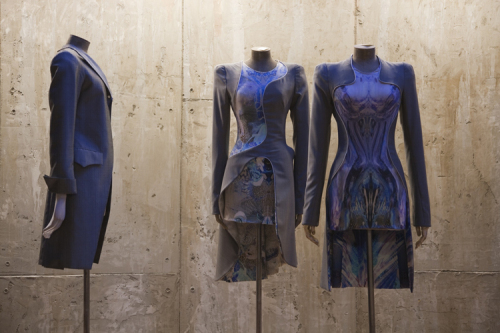
Galleries showcase recurring themes and concepts in McQueen’s work. ‚The Romantic Mind‚ examines his technical ingenuity, which combined the precision of tailoring and pattern making with the spontaneity of draping and dressmaking. ‚Romantic Gothic‚ highlights McQueen’s historicism, particularly his engagement with the Victorian Gothic, and dichotomies such as life and death. ‚Romantic Nationalism‚ looks at McQueen’s patriotic impulses, including his reflections on his Scottish heritage and his fascination with British history. ‚Romantic Exoticism‚ explores the influence of other cultures on the designer’s imagination, especially China and Japan. ‚Romantic Primitivism‚ captures McQueen’s engagement with the ideal of the ’noble savage‘, while ‚Romantic Naturalism‚ considers his enduring interest in raw materials and forms from nature.
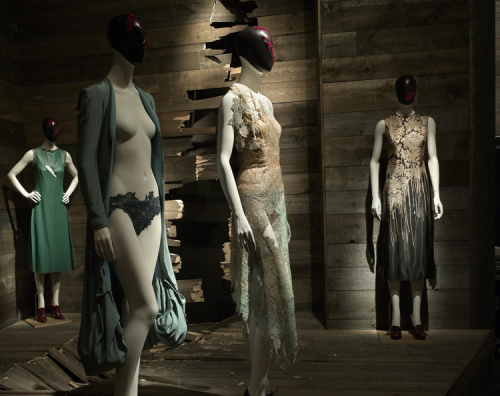
Alexander McQueen doggedly promoted freedom of thought and expression and championed the authority of the imagination. In this, he was an exemplar of the Romantic individual, the hero-artist who staunchly followed the dictates of his inspiration. ‚What I am trying to bring to [fashion] is a sort of originality,‘ he once commented. McQueen expressed this originality most fundamentally through his methods of cutting and construction, which were both innovatory and revolutionary. This technical ingenuity was apparent as early as his graduation collection from the Fashion Design MA course at Central Saint Martins College of Art and Design in London. Entitled Jack the Ripper Stalks His Victims (1992), it introduced such iconic designs as the three-point ‚origami‘ frock coat. In his first collection after graduating, entitled Taxi Driver (A/W 1993–94), McQueen launched his ‚bumsters,‘ pants that sat so low on the hips they revealed the buttocks. Indeed, McQueen was such an assured designer that his forms and silhouettes were established from his earliest collections, and remained relatively consistent throughout his career. Referring to his early training on Savile Row in London, McQueen has said, ‚Everything I do is based on tailoring.‘ McQueen’s approach to fashion, however, combined the precision and traditions of tailoring and pattern making with the spontaneity and improvisations of draping and dressmaking, an approach that became more refined after his tenure as creative director of Givenchy in Paris. It is this approach, at once rigorous and impulsive, disciplined and unconstrained, that underlies McQueen’s singularity and inimitability.
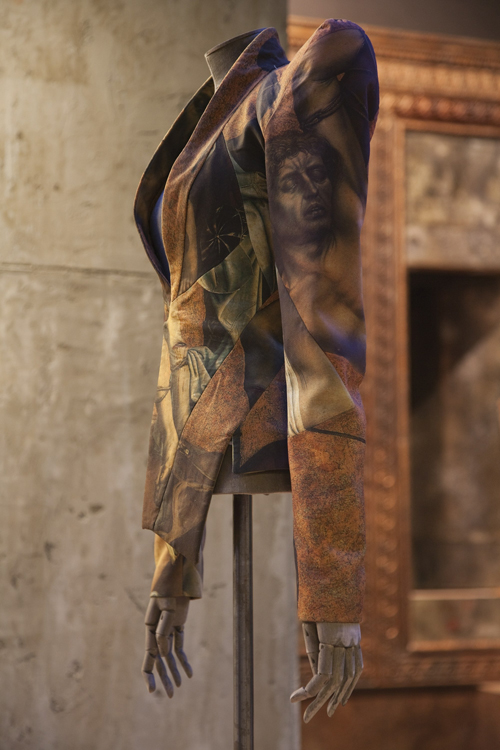
One of the defining features of Alexander McQueen’s collections was their historicism. While McQueen’s historical references were far-reaching, he was inspired particularly by the nineteenth century, drawing especially on the Victorian Gothic. ‚There’s something … kind of Edgar Allan Poe, kind of deep and kind of melancholic about [my] collections,‘ McQueen once observed. Indeed, the ’shadowy fancies‘ that Poe writes about in The Fall of the House of Usher (1839) are vividly present within the majority of McQueen’s collections, most notably Dante (A/W 1996-97) Supercalifragilisticexpialidocious (A/W 2002–3), and his posthumous collection unofficially entitled Angels and Demons (A/W 2010–11).
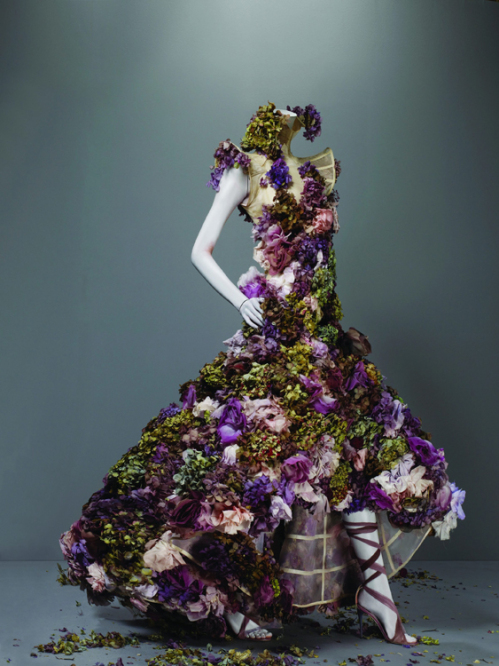
Like the Victorian Gothic, however, which combines elements of horror and romance, McQueen’s collections often reflected paradoxical relationships such as life and death, lightness and darkness. Indeed, the emotional intensity of his runway presentations was frequently the consequence of the interplay between such dialectical oppositions. The relationship between victim and aggressor was especially apparent within McQueen’s collections, particularly in his accessories. He once remarked, ‚I … like the accessory for its sadomasochistic aspect.‘ This position is strikingly evident in the ‚Cabinet of Curiosities,‘ which focuses on atavistic and fetishistic paraphernalia produced by McQueen in collaboration with a number of accessory designers including the milliners Dai Rees and Philip Treacy and the jewelers Shaun Leane, Erik Halley, and Sarah Harmarnee.
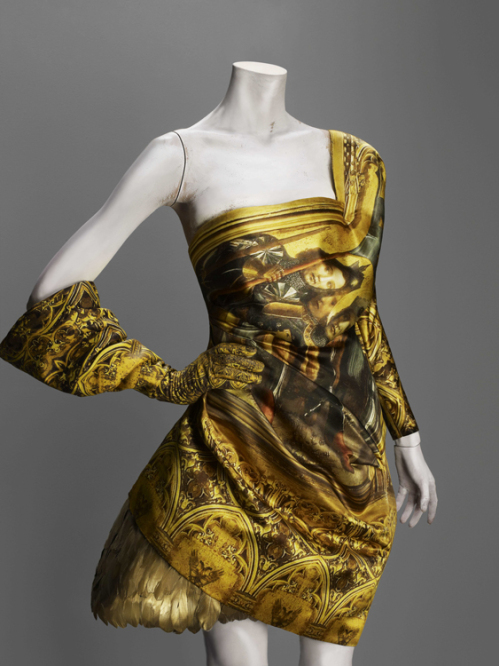
Alexander McQueen’s collections were fashioned around elaborate narratives that were profoundly autobiographical, often reflecting upon his ancestral history, specifically his Scottish heritage. Indeed, when he was asked once what his Scottish roots meant to him, the designer responded, ‚Everything.‘ McQueen’s national pride is most evident in Highland Rape (A/W 1995–96) and Widows of Culloden (A/W 2006–7). Both collections explored Scotland’s turbulent political history. Highland Rape was based on the eighteenth-century Jacobite Risings and the nineteenth-century Highland Clearances, and was the first collection to introduce McQueen tartan. Shown on semi-naked, blood-spattered models that staggered down a runway strewn with heather and bracken, the collection was intended to counter romantic images of Scotland.
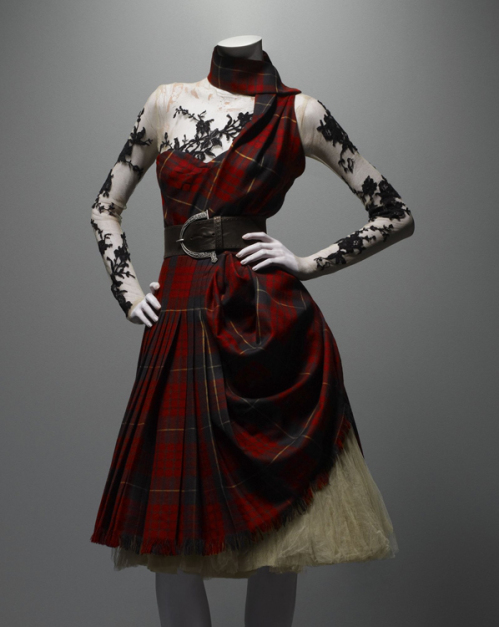
In contrast, Widows of Culloden, which was based on the final battle of the Jacobite Risings, was more wistful, featuring exaggerated silhouettes inspired by the 1880s. McQueen’s message, however, remained defiantly political: ‚What the British did there was nothing short of genocide.‚ Despite these heartfelt declarations of his Scottish national identity, McQueen felt intensely connected to England, especially London. ‚London’s where I was brought up. It’s where my heart is and where I get my inspiration,‚ he once stated. His deep interest in the history of England was most apparent, perhaps, in The Girl Who Lived in the Tree (A/W 2008–9), a dreamy quixotic fairy tale inspired by an elm tree in the garden of McQueen’s country home near Fairlight Cove in East Sussex. Influenced by the British Empire, it was one of McQueen’s most romantically nationalistic collections, albeit heavily tinged with irony and pastiche.
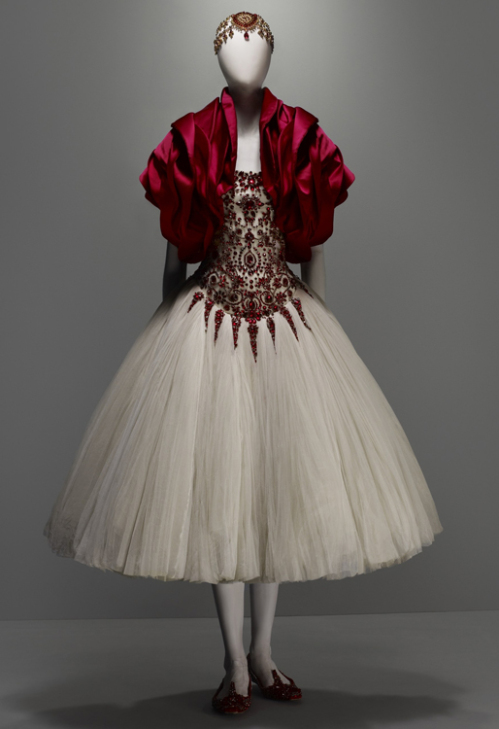
Alexander McQueen’s romantic sensibilities expanded his imaginary horizons not only temporally but also spatially. As it had been for artists and writers of the Romantic Movement, the lure of the exotic was a central theme in McQueen’s collections. Like his historicism, McQueen’s exoticism was wide-ranging. India, China, Africa, and Turkey were all places that sparked the designer’s imagination. Japan was particularly significant to McQueen, both thematically and stylistically. The kimono, especially, was a garment that the designer endlessly reconfigured in his collections. Indeed, McQueen’s exoticism was often formalistic. Remarking on the direction of his fashions, he once commented, ‚[My work will be about] taking elements of traditional embroidery, filigree and craftsmanship from countries all over the world. I will explore their crafts, patterns and materials and interpret them in my own way.‘ But as with many of his themes, McQueen’s exoticism often expressed itself in contrasting opposites. This was the case with It’s Only a Game (spring/summer 2005), a show staged as a chess game inspired by a scene in the film Harry Potter and the Sorcerer’s Stone (2001), which pitched the East (Japan) against the West (America).
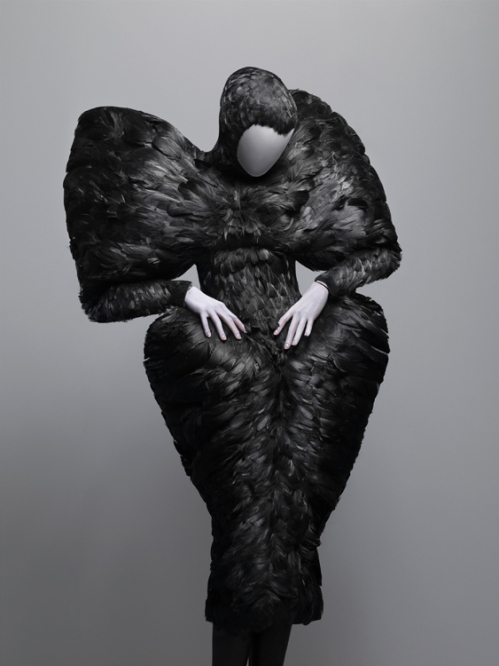
Films often inspired McQueen, as did contemporary art. VOSS (S/S 2001), which featured a number of exoticised garments including a coat and a dress appliquéd with roundels in the shape of chrysanthemums, was inspired by a photograph of Joel Peter Witkin entitled Sanitarium (1983) which depicted an obese woman connected via a breathing tube to a stuffed monkey. On McQueen’s runway, the role of the obese woman was played by the fetish writer Michelle Olley. Typical of McQueen’s collections, VOSS offered a commentary on the politics of appearance, upending conventional ideals of beauty. For McQueen, the body was a site for contravention, where normalcy was questioned and where the spectacle of marginality was embraced and celebrated.
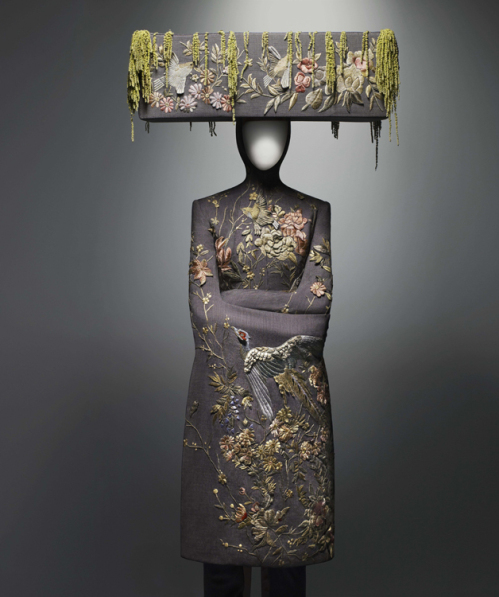
Throughout his career, Alexander McQueen frequently returned to the theme of primitivism, which drew upon the ideal of the noble savage living in harmony with the natural world. It was the focus of his first runway collection after graduating, entitled Nihilism (S/S 1994). Of the collection, McQueen commented ‚[It] was a reaction to designers romanticising ethnic dressing, like a Masai-inspired dress made of materials the Masai could never afford.‚ Famously it included a latex dress with locusts, McQueen’s statement on famine. Many of the pieces were coated with mud, a conceit the designer repeated in Eshu (A/W 2000–2001), a collection inspired by one of the most well-known deities of Yoruba mythology. The clothes almost fetishised materials, including a coat of black synthetic hair and a dress of black horse hair embroidered with yellow glass beads.
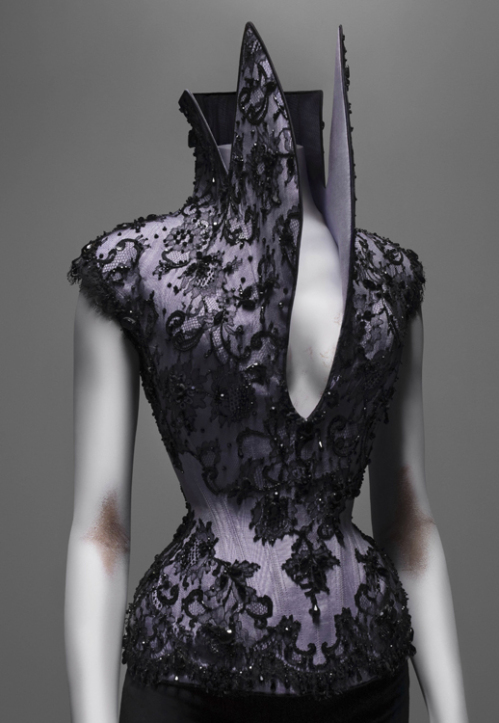
This was also the case in It’s a Jungle Out There (A/W 1997–98), which was based on the theme of the Thomson’s Gazelle. The collection was a meditation on the dynamics of power, in particular with the dialectical relationship between predator and prey. Indeed, McQueen’s reflections on primitivism were frequently represented in paradoxical combinations, contrasting modern and primitive, civilised and uncivilised. The storyline of Irere (S/S 2003) involved a shipwreck at sea and was peopled with pirates, conquistadors, and Amazonian Indians. Typically, McQueen’s narrative glorified the state of nature and tipped the moral balance in favor of the ’natural man‘ or ’nature’s gentleman‘ unfettered by the artificial constructs of civilisation.
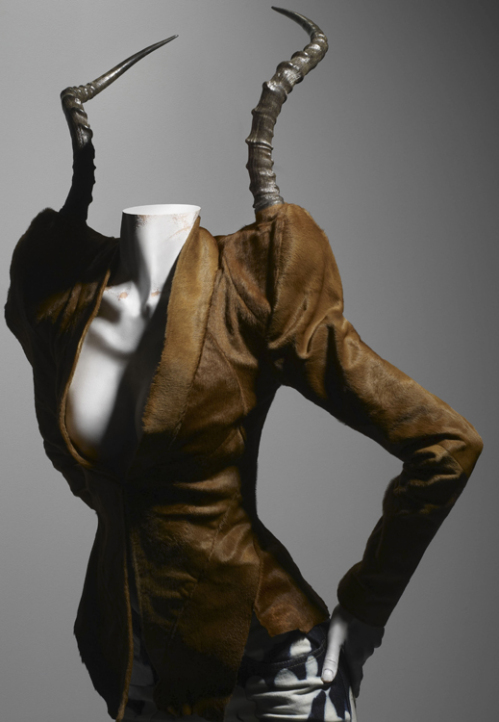
Nature was the greatest, or at least the most enduring, influence upon Alexander McQueen. It was also a central theme, if not the central theme of Romanticism. Many artists of the Romantic Movement presented nature itself as a work of art. McQueen both shared and promoted this view in his collections, which often included fashions that took their forms and raw materials from the natural world. But for McQueen, as it was for the Romantics, nature was also a locus for ideas and concepts. This is most clearly reflected in Plato’s Atlantis (S/S 2010), the last fully-realised collection the designer presented before his death in February 2010. Inspired by Charles Darwin’s On the Origin of Species (1859), it presented a narrative that centered not on the evolution of humankind but on its devolution.
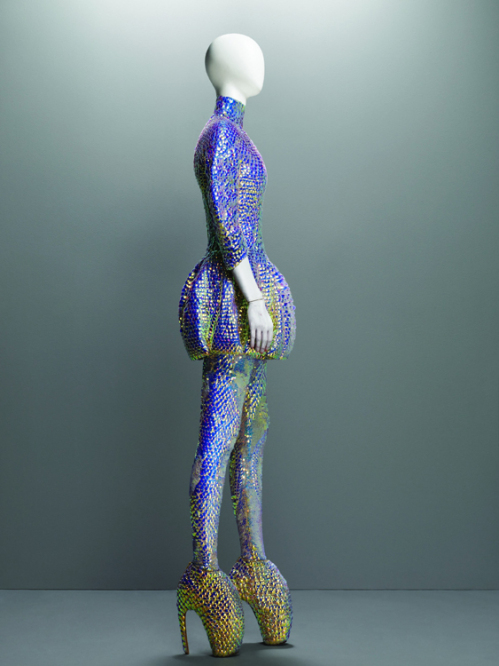
The collection was streamed live over the Internet on Nick Knight’s SHOWstudio.com in an attempt to make fashion into an interactive dialogue between creator and consumer. For the Romantics, nature was the primary vehicle for the Sublime – starry skies, stormy seas, turbulent waterfalls, vertiginous mountains. In Plato’s Atlantis, the sublime experience of nature was paralleled and supplanted with that of technology – the extreme space-time compressions produced by the Internet. It was a powerful evocation of the Sublime and its coincident expression of the Romantic and the Postmodern. At the same time, it was a potent vision of the future of fashion that reflected McQueen’s sweeping imagination.
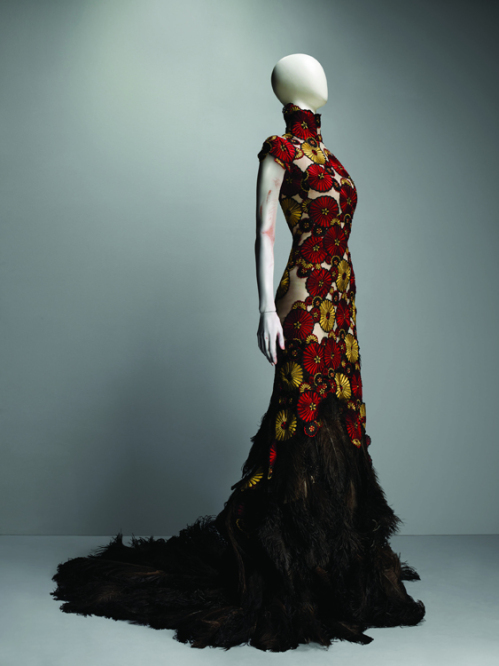
One of my favourite AMQ moments is when he, as a finale of his S/S 1999 show, placed the theatrical model Shalom Harlow on a turning platform. Two robot arms, borrowed from Fiat, used graffiti spray cans to sprinkle on a virginal Alice in Wonderland-ish trapeze dress she was wearing. Harlow, professionally showing dramatic poses gave a memorable fashion moment never to be forgotten. The transformation of the white dress into a high class street-style inspired piece of art was controlled only by the choice of colours used: green, black and yellow. Mixed up to a fresh, quirky pattern it was serendipity design at its very best.
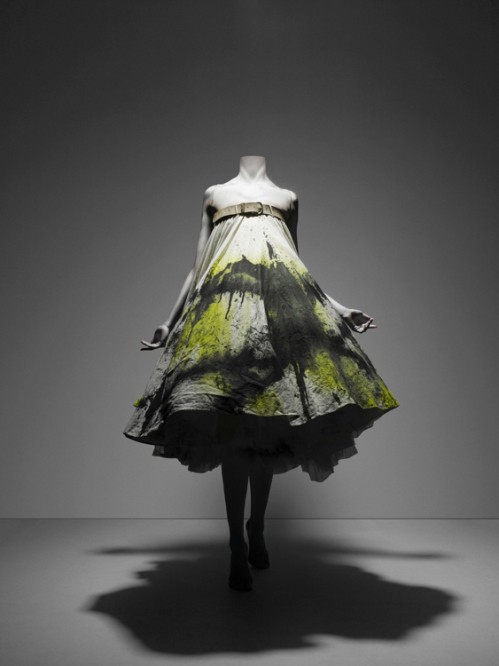
‚I want to be the purveyor of a certain silhouette or a way of cutting, so that when I’m dead and gone people will know that the twenty-first century was started by Alexander McQueen.‘ he once said. We do know.
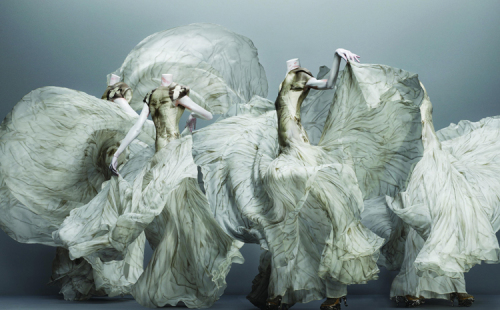
Guided Tours:
Guided tours of the exhibition are given at 10:00, Tuesday–Friday, from Wednesday, May 4 through Friday, June 10
Gallery Talks: Reading McQueen
Discover the art and literature that inspired fashion designer Alexander McQueen’s unique vision. These gallery talks take place in the permanent collection and meet at 3:45 at the Tours sign at the south end of the Great Hall.
Friday, June 17: Kathryn Calley Galitz
Friday, July 15: Tim Barringer
If you have time, go see the Richard Serra drawing exhibition just to your left when you come out. It’s relaxative to dive into the bold black surfaces after all the impression you will be left with after Savage Beauty.
